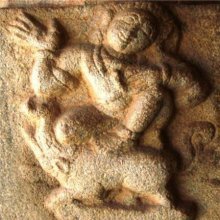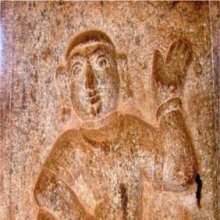Hamsapaksha, Hamsa-paksha, Haṃsapakṣa: 7 definitions
Introduction:
Hamsapaksha means something in Hinduism, Sanskrit. If you want to know the exact meaning, history, etymology or English translation of this term then check out the descriptions on this page. Add your comment or reference to a book if you want to contribute to this summary article.
The Sanskrit term Haṃsapakṣa can be transliterated into English as Hamsapaksa or Hamsapaksha, using the IAST transliteration scheme (?).
Images (photo gallery)
In Hinduism
Natyashastra (theatrics and dramaturgy)
Source: Wisdom Library: Nāṭya-śāstraHaṃsapakṣa (हंसपक्ष, “swan-wings”) refers to a gesture (āṅgika) made with a ‘single hand’ (asaṃyuta), according to the Nāṭyaśāstra chapter 8. The hands (hasta) form a part of the human body which represents one of the six major limbs (aṅga) used in dramatic performance. With these limbs are made the various gestures (āṅgika), which form a part of the histrionic representation (abhinaya).
Source: archive.org: The mirror of gesture (abhinaya-darpana)Haṃsapakṣa (हंसपक्ष, “swan-feather”):—One of the Twenty-eight Single Hands (hasta).—the little finger of the Sarpa-śīrṣa hand is extended. Usage: the number six, constructing abridge, making marks with the nails, arranging.
According to another book: same definition. It is said to beassociated with tāṇḍava dancing, and springs from Tāṇḍi. Itssage is Bharata, its colour indigo, its race Apsara, its patrondeity the God of Love (Pañcasāyaka) . Usage: constructing abridge, restraining, gathering, feathers of a bird, completion, drawing a portrait (rūpa-lekhana) , dusky colour, Apsara caste, and in Śubha-nāṭya.
Source: archive.org: Natya ShastraHaṃsapakṣa (हंसपक्ष, “swan-wings”).—A type of gesture (āṅgika) made with a single hand (asaṃyuta-hasta);—(Instructions): The three fingers stretched, the little finger raised and the thumb bent.
(Uses): It is used to indicate pouring libation of water, and things connected with smell, acceptance of a gift, Ācamana and taking meals by Brahmins, embrace, excessive stupor, horripilation, touch, unguent and gentle massage. It may again be used to indicate according to the Sentiment, amorous action of women relating to the region between their breasts, their sorrow and touching of their chin.
Source: Shodhganga: Elements of Art and Architecture in the Trtiyakhanda of the Visnudharmottarapurana (natya)Haṃsapakṣa (हंसपक्ष) refers to one of the twenty-two Asaṃyuktahastas or “single hand gestures” (in Indian Dramas), according to the Viṣṇudharmottarapurāṇa, an ancient Sanskrit text which (being encyclopedic in nature) deals with a variety of cultural topics such as arts, architecture, music, grammar and astronomy.—The hasta-mudrās (lit. “hand-gestures”) are very essential to denote some particular action or state in dancing and these mudrās are formed with the help of hands and fingers.—The word haṃsapakṣa consists of two words viz., haṃsa and pakṣa. The word haṃsa is already explained in the context of haṃsavaktra-hasta. It means swan. The word pakṣa means wings . So the word haṃsapakṣa denotes the wings of a swan. In the Viṣṇudharmottarapurāṇa, this hand posture is described as one where the little finger of the hand is lifted crookedly and the thumb is bent. In the Abhinayadarpaṇa it is instructed that the theme of using haṃsapakṣa-hasta, the hand should be kept in sarpaśīrṣa-hasta. The remaining instructions of this work are same with the Viṣṇudharmottarapurāṇa. According to the Viṣṇudharmottarapurāṇa, some activities like touching, anointing and shampooing are denoted through this hastamudrā.
According to the Abhinayadarpaṇa, the number six is denoted by this posture. Some activities like building of a bridge, putting nail marks and covering something are also indicated through the haṃsapakṣa hand posture.

Natyashastra (नाट्यशास्त्र, nāṭyaśāstra) refers to both the ancient Indian tradition (shastra) of performing arts, (natya—theatrics, drama, dance, music), as well as the name of a Sanskrit work dealing with these subjects. It also teaches the rules for composing Dramatic plays (nataka), construction and performance of Theater, and Poetic works (kavya).
Languages of India and abroad
Sanskrit dictionary
Source: DDSA: The practical Sanskrit-English dictionaryHaṃsapakṣa (हंसपक्ष).—a particular position o the hand.
Derivable forms: haṃsapakṣaḥ (हंसपक्षः).
Haṃsapakṣa is a Sanskrit compound consisting of the terms haṃsa and pakṣa (पक्ष).
Source: Cologne Digital Sanskrit Dictionaries: Monier-Williams Sanskrit-English DictionaryHaṃsapakṣa (हंसपक्ष):—[=haṃsa-pakṣa] [from haṃsa] m. a [particular] position of the hand, [Catalogue(s)]
[Sanskrit to German]
Sanskrit, also spelled संस्कृतम् (saṃskṛtam), is an ancient language of India commonly seen as the grandmother of the Indo-European language family (even English!). Closely allied with Prakrit and Pali, Sanskrit is more exhaustive in both grammar and terms and has the most extensive collection of literature in the world, greatly surpassing its sister-languages Greek and Latin.
See also (Relevant definitions)
Partial matches: Paksha, Hamsa.
Starts with: Hamsapakshahasta.
Query error!
Full-text: Hamsapakshahasta, Udvritta, Vardhamana, Wing, Recita, Shampoo, Touching, Anointing, Dandapaksha, Six, Building, Nail-mark, Swan, Covering, Hasta, Asamyuta, Asamyuktahasta.
Relevant text
Search found 6 books and stories containing Hamsapaksha, Haṃsa-pakṣa, Hamsa-paksa, Hamsa-paksha, Haṃsapakṣa, Hamsapaksa; (plurals include: Hamsapakshas, pakṣas, paksas, pakshas, Haṃsapakṣas, Hamsapaksas). You can also click to the full overview containing English textual excerpts. Below are direct links for the most relevant articles:
Abhinaya-darpana (English) (by Ananda Coomaraswamy)
Hastalaksanadipika a critical edition and study (by E. K. Sudha)
3. Gestures employed in Kathakali and Kutiyattam against Hastalaksanadipika < [Chapter 3 - Later developments of dramatic techniques]
Chapter 8 - English Translation of the Hastalaksanadipika (Hasta-Lakshana-Deepika)
Vishnudharmottara Purana (Art and Architecture) (by Bhagyashree Sarma)
2.2. Hand Postures (a): Asaṃyukta-hasta < [Chapter 3 - Drama and Dance]
2. The Viṣṇudharmottara-purāṇa and the Indian Classical Dances < [Chapter 6 - Modern Relevance of Different Art Forms and Architecture]
Arts in the Puranas (study) (by Meena Devadatta Jeste)
5. Hasta-mudras (gestures of the hands) < [Chapter 2 - Dance in the Puranas]
Natyashastra (English) (by Bharata-muni)
Gati in Theory and Practice (by Dr. Sujatha Mohan)
Description of Gati as in Bharatārṇava < [Chapter 2 - Concept and technique of Gati]
Description of Gati in Abhinayadarpaṇa < [Chapter 2 - Concept and technique of Gati]

